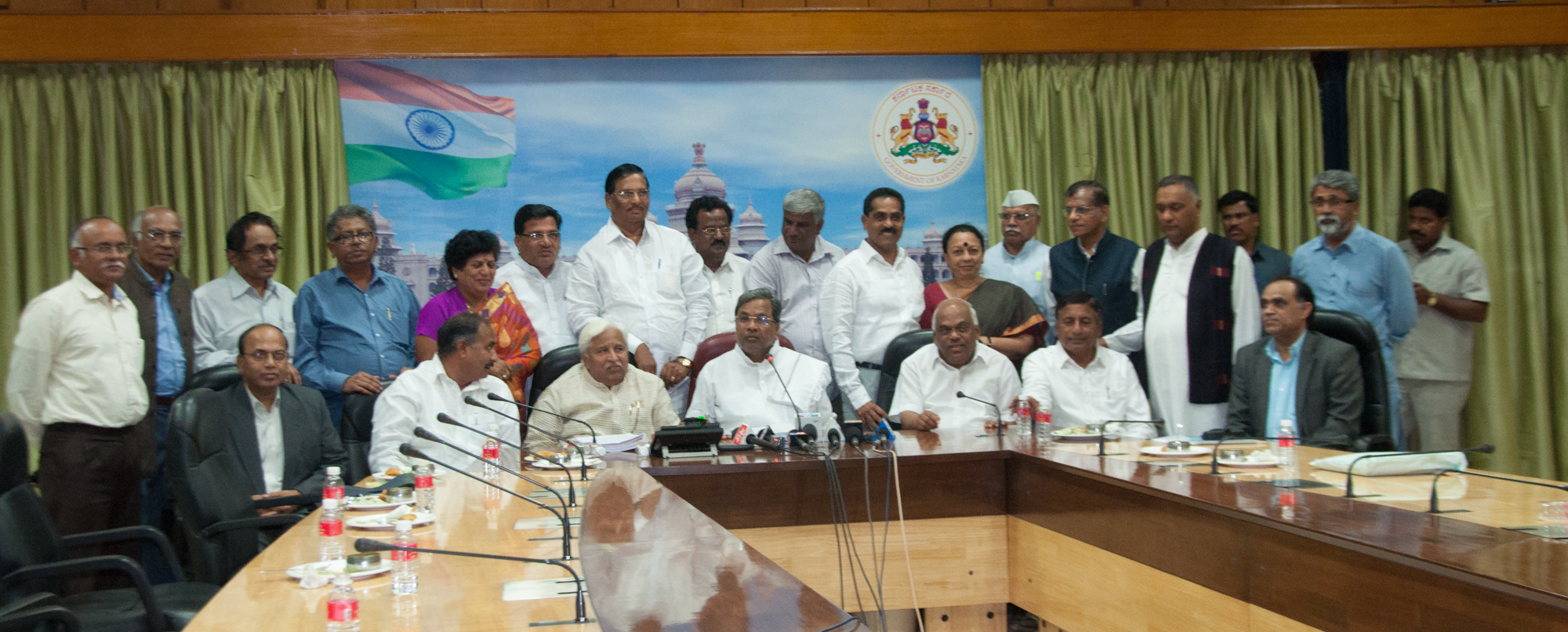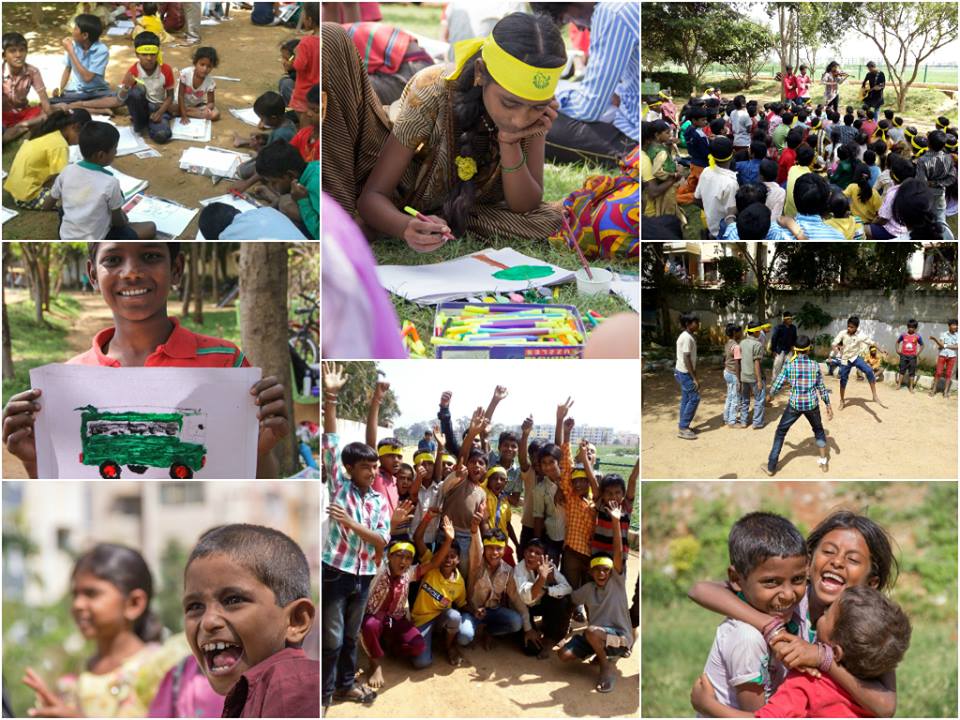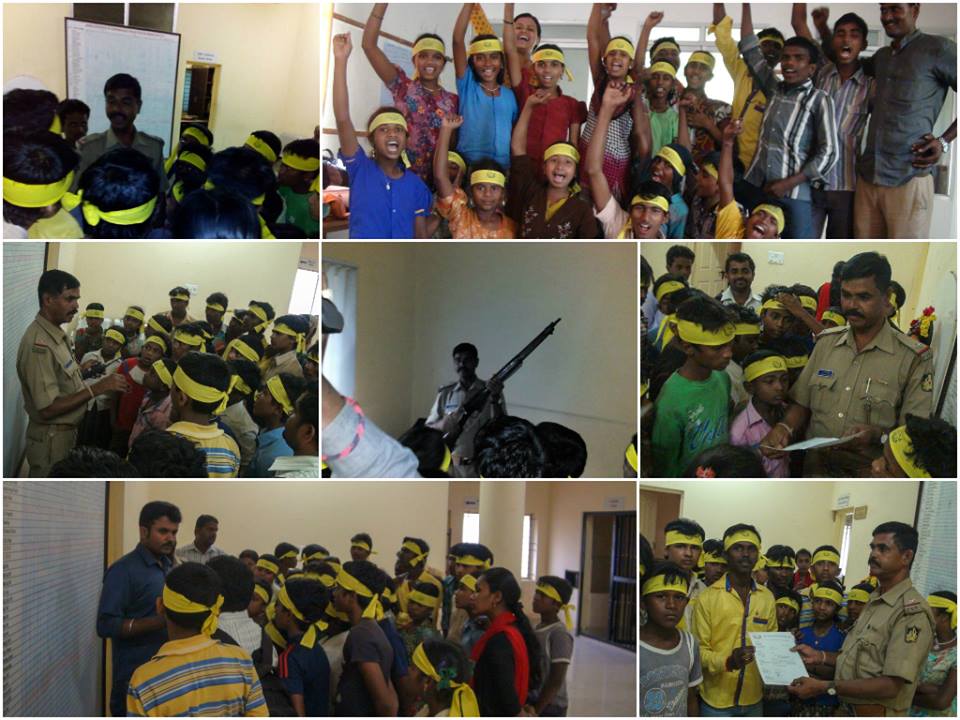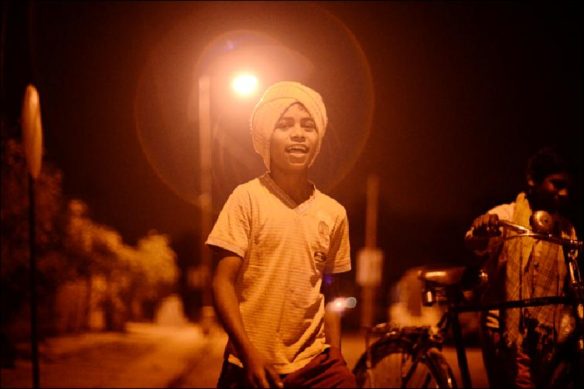Issue03_December
In this Issue:
- Karnataka Panchayat Raj Act Amendment Committee Report, 2014: Making Grama Swaraj a reality
- Who ensures children’s right to protection?
- Third Asian Forum on the Rights of the Child held in August 2014 in Ulaanbaatar, Mongolia
- Celebrating Child Rights Week while commemorating the 25th Anniversary of United Nations Convention of the Rights of the Child
- Suggested readings
- News you may have missed earlier
Karnataka Panchayat Raj Act Amendment Committee Report, 2014: Making Grama Swaraj a reality

Karnataka Panchayat Raj Amendment Committee with Karnataka Chief Minister, Siddaramaiah and H. K Patil – Minister for Rural Development and Panchayat Raj (Karnataka)
The Grama Panchayat Hakottaya Andolana (the secretariat of which is The Concerned for Working Children) heartily welcomes the recommendations of the Karnataka Panchayat Raj Act Amendment Committee 2014. Ensuring the realisation of the aspirations of people through Grama Sabhas and Grama Panchayats and upholding the constitutional mandate of the local self governments – the two main objectives of the Andolana find resonance in the recommendations of the Committee. Following our struggles, initiatives, experiments and sustained conversations to empower the Grama Sabhas and Grama Panchayats, the intent of the Committee and its deeply people centered recommendations are both heartening and inspiring. We believe these recommendations contribute significantly to the political decentralisation and empowerment of the Panchayati Raj in Karnataka, thereby making it a role model for the entire country.
In the Committee set up under the chairpersonship of the former Speaker of Karnataka Legislature, Sri. Ramesh Kumar, Smt. Nandana Reddy, Convenor of the Grama Panchayat Hakkottaya Andolana and Director – Development at The Concerned for Working Children, is one of the core-committee members. The Committee, as part of its review process had carried out four regional level consultations in which district representatives of Andolana took part in significant numbers – and presented views and suggestions, which have clearly been received with seriousness and sincerity. This report was presented by the Committee members to the Honorable Chief Minister of Karnataka, Sri. Siddaramaiah and Sri. H. K Patil, Minister for Rural Development and Panchayat Raj (Karnataka) on the 6th of November 2014.
We specially welcome the Committee’s emphasis on the Grama Sabhas and Grama Panchayats and the many suggestions that pertain to them exclusively. For the very first time, the roles and responsibilities of the Grama Sabhas have been clearly articulated and the three levels of the panchayats have been made answerable to the Grama Sabhas that form their constituency. This will ensure a high degree of transparency and accountability.
The emphasis laid on the participation of the most marginalized communities in all aspects of local governance in the Report creates opportunities for the participation of members of the socially disadvantaged groups including women and children. The Committee has recommended that the Special Grama Sabhas for members of the Scheduled Castes and Scheduled Tribes, women and children be mandatory, instead of being driven through annual circulars. By recommending that prior to the ward sabhas, there be hamlet or habitation based sabhas, the Committee has attempted to ensure high community participation both in terms of access as well as making them more meaningful through bottom up planning processes.
In its report, the Committee has argued in detail why and how the devolution of functions, functionaries and finances is critical if the Grama Sabhas and Panchayats have to fulfil their constitutional mandate. As of today, it is not compulsory for government officials to take part in panchayat meetings and to provide required information to them. The Committee makes it clear that the officials are accountable to the decisions taken at the Grama Sabhas and in the Panchayats and that they are answerable to the people and the panchayats they serve.
The Committee’s recommendations include – planning processes that are carried out at the village level, based on the best interests of the community members, with their participation through a systematic process that also takes into account data and statistics; consolidation of plans at the taluk, zilla and state levels in a bottom up manner; setting up of Planning Committees at the taluk, zilla and state levels to discuss the appropriate responses to concerns and to develop comprehensive plans; membership of representatives of the Village and city local governments in all levels of the Planning Committees; absence of provision to change the decisions taken and passed at the local level – All these recommendations protect the interests of the people and the local governments. Andolana believes that they reinforce the sanctity of people’s participation in governance. The Committee also suggests that all the three levels of the panchayats should periodically submit their reports to the Grama Sabha. This will most certainly enhance the accountability of Grama, Taluk and Zilla Panchayats to the Grama Sabhas.
Recommendations to confirm a full five year term for the post of the Panchayat President, election of the president by all elected members of the panchayat (as is now), naming the presidents as the Chief Executive Officers of their respective panchayats are all endorsed by the Andolana. They ensure a reasonable time-frame for the functioning of the president and her/his election by other members of the panchyat ensures her/his accountability to them as well as to the Grama Sabha. This will reinforce transparency. There has been a view expressed in the state by few that there should be a direct election of the president by the constituency and it must be stated that the Andolana is totally opposed to it as it undermines participatory democracy – it is glad to note the Committee’s recommendations do not endorse direct election.
The Committee points out that development is not about conducting activities, instead development is fulfilling responsibilities. Instead of the Activity Mapping which is prescribed for the three levels of the government, the Committee has suggested detailed ‘Responsibility Mapping’, identifying the specific responsibilities that have to be carried out at each level of the local government. This will also enhance organic links between the three levels and enable a harmonious functioning among them.
Many of the recommendations by this Committee are quite revolutionary. We urge the government to accept these recommendations, make the required changes in the law and implement them in letter and in spirit.
Read the full report in English/Kannada and for further details on the Committee
Who ensures children’s right to protection ?
In December 2013, our Makkala Mitra Helpline (0-9449031270) received a call from a child who prefered to remain anonymous. He had seen the Helpline number on The Concerned for Working Children’s Makkala Toofan TV programme and wanted to report the wrongful practices of his school based in Shimoga district (Karnataka). He shared that the school was collecting extra fees from the children over and above the legal requirement. The children who were not able to pay faced repercussions such as not being allowed equal access to school facilities, not being allowed to write their exams, scolded and humiliated in front of peers etc. This grievance was submitted by us to the Karnataka State Commission for the Protection of Child Rights (KSCPCR). The KSCPCR decided to utilise the mechanism of the state Education Department to investigate the issue. Hence, the Block Education Officer (BEO) designated was requested to investigate the matter on their behalf. The BEO, after follow-up wrote back to say that no such issue existed and statements from the school were submitted stating this, alongside his own conversation with children where they apparently denied such practices. Meanwhile, the child called back the Makkala Mitra helpline. He said that their headmaster went around all the classrooms telling the teachers to deny having collected extra fees. He also said that the BEO asked the children about the fees while their teacher was present, so they were too scared to tell the truth. The child himself outlined how this was an improper way to investigate and that the BEO should have spoken to them without their teacher being present.
Well functioning mechanisms responsible for responding to violations as expressed by children are essential to ensure a sense of well-being and safety in our children. The nature of the mechanism varies based on its context and location but its intention remains to safeguard the rights of protection that are universally held by children. Examples of complaints mechanisms vary from a locally installed complaints box for children; telephone helplines such as the ChildLine; grievance committees within formal structures and communities; the Commissions appointed to protect children’s rights at the State and National levels.
Yet considering the above narrative and the spate of abuse cases emerging from schools across Karnataka, questions regarding the efficacy of existing systems looms heavy. The Police has become the prime agency that we hear of, responding and handling these situations as against any body which is specialized and trained to handle trauma and abuse in children.
The KSCPCR, for example, is the key complaints mechanisms within the state which addresses child rights violations. Yet from the case narrated above we can easily spot the unfortunate limitations it works within. The KSCPCR has no decentralised system of its own to look into matters of violation. A total of seven members oversee violations from 30 districts with a total population of 61,130,704 (Census 2011) in Karnataka. This means that they have to lean on existing systems like those of the Education Department, leading to situations where there is a conflict of interest – the Department ends up investigating its own violations. The independent nature of the Commission remains compromised alongside issues of delay and incorrect procedures of investigation due to lack of training and perspective. Yet with the limited resources and powers, the Commission’s hands remain tied.
Without functioning and empowered complaints mechanisms that actively work towards highlighting situations of abuse and ensuring certain consequences to perpetrators of right’s violations, children are at a heightened risk of abuse and exploitation. It is the absolute responsibility of the duty bearer, in this case the State, to ensure that rights of all are adequately protected through various mechanisms. Ineffective mechanisms imply a serious dereliction of duty by the State.
It is also important that these complaints mechanisms respond to the complaint in a holistic manner. In order to build a cohesive understanding of the child’s needs in situations of abuse, there is need to ensure that the mechanism keeps at its heart the right of the child to be qualitatively heard. It is important that mechanisms move beyond the mere investigation and punishment mode to also look at rehabilitation and reintegration where required. Hence, complaints mechanisms must be connected to counseling, support and referral systems.
Child friendly complaint mechanisms which ensure appropriate follow up and genuinely offer solace and security to the child are the need of the hour. Unless this is done, reporting will remain poor as children, worried about repercussions and with no expectation of justice, would be forced to suffer in traumatised silence.
Third Asian Forum on the Rights of the Child held in August 2014 in Ulaanbaatar, Mongolia
National Human Rights Commission of Mongolia, National Authority for Children, UNICEF Mongolia and General Research Institute of the Convention of the Rights of the Child (Asian Forum) jointly organized the 3rd Asian Forum on the Rights of the Child on 23 and 24 August 2014 in Ulaanbaatar, Mongolia. Representatives of Prime Minister of Mongolia and UNICEF, Chief Commissioner of the National Human Rights Commission of Mongolia, Chair of the National Authority for Children in Mongolia, Chair of the Asian Forum, of the Korean Council for Children’s Rights were among the distinguished delegates who attended the conference. Ganapathi M M, Assistant Director of The Concerned for Working Children (CWC) attended the forum and helped draft the Declaration of the Third Asian Forum on the Rights of the Child. CWC’s ties with the Mongolia goes a long way back when Nandana Reddy, one of the founders of CWC, worked with the then Mongolian government to build a governance structure which integrated qualitative children’s participation in all strata’s of the government in 2004-2005.
Asian Forum on the Rights of the Child was significant as it was consciously conducted in the year commemorating the 25th Anniversary of the adoption of the Child Rights Commission (CRC). The common theme across all sessions of the forum was ‘Creating Child-Friendly Societies in Asia – Prospects for the Realization of Children’s Rights’. The crux of the forum was a review of the past twenty five years (after the unanimous adoption of the CRC at the United Nations General Assembly) which helped understand to what extent the CRC may have helped to change the situation for children in Asia and help explore ways children realize their rights. It also threw light on understanding how to develop child friendly societies on the basis if the CRC.
The forum was divided into three sessions. The first, focused on children’s rights in the field of ‘Child labour and education’; the second session dealt with ‘Support for children and the development of child friendly cities’; and the third session took up the issue of ‘Establishment of mechanisms for the protection and promotion of children’s rights in Asia’. In each session, presentations by some speakers on their practices were heard followed by discussions on the issues. At the end of the Forum, a Declaration was drafted which aligned with the outcomes of the discussions that occurred during the entire Forum.
Ganapathi presented ‘Working Children: Citizens today’ in the first session. He explained that child labour is part of the larger conversation on children and work. He defines child labourers as per Indian laws and explained the consequences of the ban plus raid and rescue system on children. He introduced CWC’s approach to child labour, which has participation and self-determination at its helm. He spoke of the rise of Bhima Sangha, the union of working children and its work the years after. He stressed that child labour is embedded in the socio-economic and cultural fiber of the Indi and reasons for working differ for children. Hence, it is essential to understand supply side of the issue and give it equal importance. Decentralisation is an important aspect of this process to take place because the child can be best responded to locally. He also said that education is unfortunately seen as the easy fix for child labour. He threw light on issues with the implementation of ‘right to education’ in India and with public education. To explain further he shared CWC’s approach to education and introduced the learnings from Namma Nalanda Vidya Peeta’s education system. And due to Ganapathi’s strong emphasis on the participation and engagement of children with such spaces, the Chair of the Asian Forum, Akito Kita, announced in his concluding remarks that, “Children will be invited and be a part of the Asian Forum on the Rights of the Child”. He reaffirmed the children’s right to self determination and right to participation.
Declaration of the Third Asian Forum on the Rights of the Child
Date: 2-09-2014, 16:07
(2014, Mongolia)
24 August 2014, Ulaanbaatar
We, the participants of the Third Asian Forum on the Rights of the Child, which was held in Ulaanbaatar on 23-24 August, 2014, and in line with the 25th anniversary of the adoption of the Convention on the Rights of the Child (CRC) by the United Nations,
Building on the outcomes of the First Forum in Seoul in 2009 (key theme: the Actual Situation of and Challenges to the Rights of the Child in East Asia) and the Second Forum in Tokyo in 2011 (key theme: Creating ‘A World Fit for Children’),
Empathizing with and bearing in mind the suffering and sorrow of children who are still victimized and damaged by all forms of violence against children, particularly as result of a number of disasters and armed conflicts,
Drawing attention to a large number of Asian children who suffer from poverty, all forms of human trafficking, worst forms of child labor, economic exploitation, forced labour, drug abuse as well as other forms of violence against children including child abuse, corporal punishment and bullying,
Recalling that the Geneva Declaration of the Rights of the Child, adopted by the League of Nations ninety years ago in 1924, stated that “mankind owes to the child the best it has to give”,
Reconfirming that the rights enshrined in the CRC, to which all the Asian states have become parties, must be ensured for all children in all settings with special emphasis placed on the four general principles of the CRC. Namely; non-discrimination; the best interests of the child; the right to life; survival and development and respect for the views of the child; and that all children must be respected as citizens and rights holders.
Reconfirming the importance of advancing the exchange of information and opinions as well as research on the rights of the child, including sharing data on pictures of children’s situations as well as information on legislation, policies, initiatives and practices concerning children,
Inviting other countries in Asia to join the Asia Forum on the Rights of the Child to work towards the creation of child-friendly Asian countries,
Determined to pursue the effective realization of the CRC in each state and in the whole region of Asia by promoting collaboration among researchers and experts as well as governments, international organizations, academics, NGOs/civil society and other actors with the principles of the CRC as the common ideal,
Encouraging all stakeholders to facilitate and assist children in expressing their views on all matters affecting them, including by organizing themselves for this purpose, and to create structures and mechanisms for children to participate in the formulation and implementation of laws, policies, program and other measures concerning them,
Have agreed to promote the following initiatives for the development of “child-friendly societies in Asia”, which is the key theme of the Third Forum in Ulaanbaatar,
- To urge all State Parties in Asia, which have acceded to the CRC, should take initiatives to adapt and pass laws fulfilling children’s rights and giving them legal status.
- To implement policies based on the purposes and provisions of the CRC and its Optional Protocols, especially during disasters and armed conflict, which frequently occur, including during recovery and reconstruction efforts; in particular, to listen carefully to children and create mechanisms which make children partners in recovery and reconstruction processes.
- To accelerate the development and implementation of policies, legislation, awareness-raising activities and other measures for the prevention and prohibition of all forms of violence against children, including child abuse, corporal punishment and bullying; through these initiatives, to develop comprehensive plans and codes of conduct for the prevention and prohibition of all forms of violence against children.
- To prohibit the worst forms of child labour and to provide children engaged in the worst forms of child labour and their families with viable alternatives, while taking all measures to ensure the right to education and secure children’s growth and development. The viable alternatives must be decided after consultation with children and their families who will benefit from the policies. Children and families should take part in monitoring and evaluating the programmes designed for them.
- In order to ensure that children’s lives are protected and that they can grow up and develop in a safe and secure environment, to conduct review from children’s rights perspectives of the relevant policies formulated by adults from adults perspectives, with a view to restructuring such policies.
- To provide comprehensive and continuous support for children as well as their parents and families; and to promote a diversity of support policies, including the improvement of conditions of day-care workers, teachers and other supporters who work with children, with a view of protecting their rights so that they can provide appropriate support for children.
- To develop mechanisms and systems for advancing the protection, promotion and monitoring of children’s rights in a multifaceted way at local, national and regional levels and to promote networking for the effective functioning of these mechanisms and systems; in particular, to develop specific mechanisms, urgently and effectively which children can easily access in order to be given effective remedies.
- To promote the ratification of or accession to the three Optional Protocols to the CRC, with a view to ensure the effective implementation of the CRC.
- To work towards the creation of ‘child-friendly Asian societies’ on the basis of the national initiatives for ‘child-friendly cities/communities’, via the collaboration of governments, UNICEF and other international organizations, academics, NGOs/civil society and other stakeholders; as well as taking into account the opinions of children in the region.
Celebrating Child Rights Week
The Concerned for Working Children celebrated Child Rights Week all through the days leading to the Child Rights Day on 20th November. This year’s celebration had a larger purpose of commemorating the 25th Anniversary of the Declaration of the United Nations Convention on the Rights of the Child (UNCRC). The UNCRC is a human rights treaty which sets out the civil, political, economic, social, health and cultural rights of children.
The Concerned for Working Children conducted a series of activities especially for the children of migrant communities we work with. Activities involving play, art and music, a visit to the police station were some of the programmes children indulged in.
Watch children at play in the event hosted by The Concerned for Working Children in association with organisations KiliKili and Headstreams during the Child Rights Week.

Suggested Readings
- Mani Shankar Ayar’s remarks on the proposed Gram Swaraj Report
- Next Cabinet meeting to discuss proposal for amendment to Panchayat Raj Act
- Don’t criminalize child labour
Recent stories you may have missed
- The new Juvenile Justice Bill: In whose best interests?
- Creating governance spaces for marginalised voices: Piloting the Special Women’s Gram Sabhas in Udupi
- 4 children. 2 International events. 1 message – Children are citizens today
- Makkala Area Sabha held for the very first time in Bangalore





